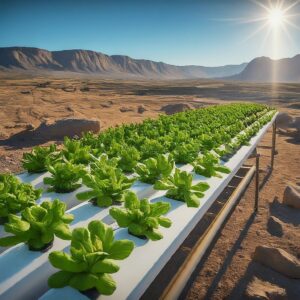Growing Plants on Unfertile Land with Aquaponics. Hey there, plant lovers! Ever find yourself staring at a sad, barren patch of dirt and thinking, “I wish something could grow here”? Well, guess what? You’re in luck! We’re about to dive into the wild world of Aquaponics—an amazing way to turn unfertile land into a garden oasis. So grab your gardening gloves (and maybe a cup of coffee) because we’re about to sprinkle some magic on that lifeless soil!
What’s Aquaponics, You Ask?
Aquaponics is like the dynamic duo of farming—a genius combo of aquaculture (raising fish) and hydroponics (growing plants in water). Imagine a world where fish and plants are best buds, helping each other out like roommates who actually get along. The fish do their thing (you know, swimming and…uh…pooping), and that waste gets turned into nutrients for the plants. In turn, the plants clean the water for the fish. Everybody wins, including you!
Why Is Your Land Unfertile?
So, why won’t your land cooperate with your green-thumb dreams? Well, there could be a number of reasons. Maybe it’s lacking the nutrients plants need to grow, the soil structure’s all wrong, or perhaps it’s been contaminated. Sometimes, the land is just being stubborn, refusing to get with the program. Traditional farming struggles with these conditions, but Aquaponics is here to save the day!
The Superpowers of Aquaponics
Water Conservation:
Aquaponics is a thirsty plant’s dream come true—using up to 90% less water than traditional farming! It’s like getting the plant version of a rain dance in a drought.
Year-Round Growth:
Do you hate waiting for spring to roll around? With Aquaponics, you can grow fresh veggies all year long. Yes, even when your neighbors are shoveling snow off their driveway.
Eco-Friendly:
Since you can grow locally and reduce transportation, you’re also giving the planet a break by lowering your carbon footprint. Who knew being green could be so literal?
Cha-Ching:
Not only do you get fresh food, but Aquaponics is a money maker, too. High yields and low resource costs, and hey, you can even sell fish and veggies on the side. Side hustle, anyone?
Healthy Eating:
Your homegrown produce is fresher, tastier, and free of nasty chemicals. It’s like the Garden of Eden, minus the forbidden fruit situation.
Setting Up Your Aquaponics System
You don’t need acres of space. A backyard, or even a balcony, is enough to get started! Fish tanks will be home to your aquatic buddies, and grow beds are where the magic happens for your plants. Pumps and filters make sure everything flows like a well-oiled machine (or a well-watered garden, in this case).
Fish: Your Aquatic Allies
When picking your fish, go for species like tilapia, trout, or catfish—they’re popular for a reason. They’ll happily swim around, doing their thing, while your plants reap the benefits. And if you’re feeling fancy, why not mix it up? A diverse fish tank is more resilient and adds a bit of flair to your operation.
Plants: Grow What You Love!
Leafy greens like lettuce, spinach and herbs like basil and mint are aquaponics favorites. But if you want to push the envelope, go for tomatoes, peppers, or even strawberries. The best part? The plants don’t care if your land is a desert—they’re thriving in their own watery paradise.
The Science Behind the System
Aquaponics is a mini ecosystem in which everything has a role. Fish produce waste, bacteria break it down into nutrients, and plants absorb those nutrients. It’s basically nature’s recycling plant but without the smelly garbage trucks.
- pH Levels: Keep it between 6.8 and 7.2, and everyone’s happy—fish, plants, and you.
- Temperature and Oxygen: Fish like it cool, plants like it warm; it’s like a spa day for everyone. Just make sure they all get what they need.
Common Hiccups (And Fixes)
Even with Aquaponics, things can occasionally go sideways. Pesky pests might sneak in, or your water might turn into a funky algae soup. Not to worry—you can handle it! Regular maintenance and a bit of troubleshooting will keep things running smoothly.
Is Aquaponics the Future?
Absolutely! With cutting-edge tech like AI controlling systems, the future of Aquaponics looks bright (and leafy). It’s not just a quirky way to grow food; it’s part of the solution for food security, sustainability, and eco-friendly farming. As more people catch on, expect more support from policies and communities.
Ready to Dive In?
If transforming unfertile land into a lush garden sounds like your kind of adventure, Aquaponics is the way to go. You’ll save water, grow fresh food, and even help the planet in the process. So, what are you waiting for? Give it a try, and who knows—you might just lead the charge into a greener, more sustainable future! Growing Plants on Unfertile Land with Aquaponics.
FAQs
- Can I really grow plants on completely unfertile land using Aquaponics?
Heck yes! You’re growing in water, not dirt. The land’s fertility doesn’t even matter! - How much space do I need? |
Start small with as little as 3×3 feet, or go big with a commercial setup. It’s flexible, like yoga, but for plants. - Is Aquaponics more expensive than traditional gardening?
The initial setup might cost more, but long-term savings on water and higher yields make it totally worth it. - Can I raise any type of fish in my system?
Not every fish is aquaponics-friendly. Stick to local species that thrive in your climate—tilapia is a solid choice. - Is Aquaponics more sustainable than hydroponics?
Yep! Aquaponics creates a self-sustaining ecosystem that hydroponics just can’t match in terms of resource efficiency.
There you go—a fun, fish-friendly, and fruitful way to turn that unfertile land into a plant paradise. Who knew farming could be this cool?
Growing Plants on Unfertile Land with Aquaponics.

